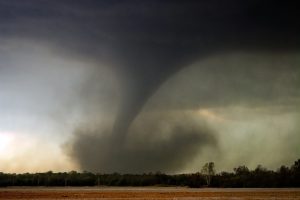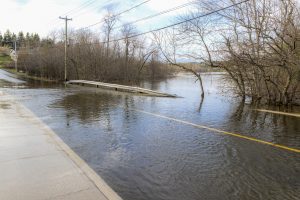In Oklahoma you need to be informed and prepared to stay safe in an array of different weather. It is always best to be prepared before the storms and know you and your family’s safety plan.
Tornadoes
Be Informed:

- Know the signs of a tornado, including a rotating, funnel-shaped cloud; an approaching cloud of debris; or a loud roar—similar to a freight train.
- Sign up for your community’s warning system. The Emergency Alert System (EAS) and National Oceanic and Atmospheric Administration (NOAA) Weather Radio also provide emergency alerts. If your community has sirens, then become familiar with the warning tone.
- Pay attention to weather reports. Meteorologists can predict when conditions might be right for a tornado.
- Identify and practice going to a safe shelter in the event of high winds, such as a safe room built using FEMA criteria or a storm shelter built to ICC 500 standards. The next best protection is a small, interior, windowless room on the lowest level of a sturdy building.
- Consider constructing your own safe room that meets FEMA or ICC 500 standards.
Safety During:
- Immediately go to a safe location that you identified.
- Take additional cover by shielding your head and neck with your arms and putting materials such as furniture and blankets around you.
- Listen to EAS, NOAA Weather Radio, or local alerting systems for current emergency information and instructions.
- If you are in a car or outdoors and cannot get to a building, cover your head and neck with your arms and cover your body with a coat or blanket, if possible.
Safety After:
- Keep listening to EAS, NOAA Weather Radio, and local authorities for updated information.
- If you are trapped, cover your mouth with a cloth or mask to avoid breathing dust. Try to send a text, bang on a pipe or wall, or use a whistle instead of shouting.
- Stay clear of fallen power lines or broken utility lines.
- Do not enter damaged buildings until you are told that they are safe.
- Save your phone calls for emergencies. Phone systems are often down or busy after a disaster. Use text messaging or social media to communicate with family and friends.
- Be careful during clean-up. Wear thick-soled shoes, long pants, and work gloves.
Floods
Be Informed:
- Know types of flood risk in your area. Visit FEMA’s Flood Map Service Center for information.
- Sign up for your community’s warning system. The Emergency Alert System (EAS) and National Oceanic and Atmospheric Administration (NOAA) Weather Radio also provide emergency alerts.
- If flash flooding is a risk in your location, then monitor potential signs, such as heavy rain.
- Learn and practice evacuation routes, shelter plans, and flash flood response.
- Gather supplies in case you have to leave immediately, or if services are cut off. Keep in mind each person’s specific needs, including medication. Don’t forget the needs of pets. Obtain extra batteries and charging devices for phones and other critical equipment.
- Purchase or renew a flood insurance policy. It typically takes up to 30 days for a policy to go into effect and can protect the life you’ve built. Homeowner’s policies do not cover flooding. Get flood coverage under the National Flood Insurance Program (NFIP)
- Keep important documents in a waterproof container. Create password-protected digital copies.
- Protect your property. Move valuables to higher levels. Declutter drains and gutters. Install check valves. Consider a sump pump with a battery.
Safety During:

- If told to evacuate, do so immediately. Never drive around barricades. Local responders use them to safely direct traffic out of flooded areas.
- Listen to EAS, NOAA Weather Radio, or local alerting systems for current emergency information and instructions.
- Do not walk, swim, or drive through flood waters. Turn Around. Don’t Drown!
- Stay off bridges over fast-moving water. Fast-moving water can wash bridges away without warning.
- If your vehicle is trapped in rapidly moving water, then stay inside. If water is rising inside the vehicle, then seek refuge on the roof.
- If trapped in a building, then go to its highest level. Do not climb into a closed attic. You may become trapped by rising floodwater. Go on the roof only if necessary. Once there, signal for help.
Safety After:
- Avoid driving, except in emergencies.
- Snakes and other animals may be in your house. Wear heavy gloves and boots during clean up.
- Be aware of the risk of electrocution. Do not touch electrical equipment if it is wet or if you are standing in water. If it is safe to do so, turn off the electricity to prevent electric shock.
- Avoid wading in floodwater, which can contain dangerous debris and be contaminated. Underground or downed power lines can also electrically charge the water.
- Use a generator or other gasoline-powered machinery ONLY outdoors and away from windows.
Earthquakes
- Happen without warning;
- Cause fires and damage roads; and
- Cause tsunamis, landslides, and avalanches.
- If an earthquake happens, protect yourself right away. Drop, Cover, then Hold On!
- If in a vehicle, pull over and stop.
- If in bed, stay there.
- If outdoors, stay outdoors.
- Do not get in a doorway.
- Do not run outside.
Be informed:
- Secure items, such as televisions, and objects that hang on walls. Store heavy and breakable objects on low shelves.
- Practice Drop, Cover, then Hold On with family and coworkers. Drop to your hands and knees. Cover your head and neck with your arms. Crawl only as far as needed to reach cover from falling materials. Hold on to any sturdy furniture until the shaking stops.
- Create a family emergency communications plan that has an out-of-state contact. Plan where to meet if you get separated.
- Make a supply kit that includes enough food and water for at least three days, a flashlight, a fire extinguisher, and a whistle. Consider each person’s specific needs, including medication. Do not forget the needs of pets. Have extra batteries and charging devices for phones and other critical equipment.
- Consider obtaining an earthquake insurance policy. Standard homeowner’s insurance does not cover earthquake damage.
- Consider a retrofit of your building to correct structural issues that make it vulnerable to collapse during an earthquake.
Safety During:
- Drop, Cover, and Hold On. Drop to your hands and knees. Cover your head and neck with your arms. Hold on to any sturdy furniture until the shaking stops. Crawl only if you can reach better cover without going through an area with more debris.
- If in bed, stay there and cover your head and neck with a pillow.
- If inside, stay there until the shaking stops. DO NOT run outside.
- If in a vehicle, stop in a clear area that is away from buildings, trees, overpasses, underpasses, or utility wires.
- If you are in a high-rise building, expect fire alarms and sprinklers to go off. Do not use elevators.
- If near slopes, cliffs, or mountains, be alert for falling rocks and landslides.
Safety After:
- Expect aftershocks to follow the largest shock of an earthquake.
- Check yourself for injury and provide assistance to others if you have training.
- If in a damaged building, go outside and quickly move away from the building.
- Do not enter damaged buildings.
- If you are trapped, cover your mouth. Send a text, bang on a pipe or wall, or use a whistle instead of shouting so that rescuers can locate you.
- If you are in an area that may experience tsunamis, go inland or to higher ground immediately after the shaking stops.
- Save phone calls for emergencies.
Once safe, monitor local news reports via battery operated radio, TV, social media, and cell phone text alerts for emergency information and instructions.





